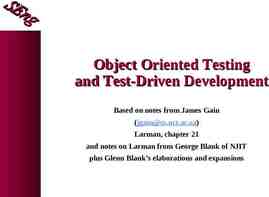An Introduction to the Git Revision Control System
27 Slides70.26 KB
An Introduction to the Git Revision Control System Jonathan Adamczewski
This presentation is not One VCS is better than another Me telling you that you should use Git Anyone suggesting that Insomniac will stop using Perforce This presentation is an introduction to Git: How it works Ways that it is or isn’t like Perforce
GIT VS PERFORCE FIGHT.
Perforce Submit Git Commit
Perforce Submit - Changelist Git Commit (verb) - Commit (noun)
Perforce Centralized storage Centralized history Centralized collaboration Connection to server is required p4 edit Git Distributed storage Distributed, divergent histories Peer to peer collaboration Central server optional ---
Perforce Files are versioned Server-wide incrementing changelist number Git Entire working copy is versioned (snapshots) Every commit has a unique SHA-1 hash from: – – – – Parent commit(s) Description Author Content
Perforce Client view maps file in depots to local files on client system Git Every clone of a git repository stores the entire history of the repository
“A Perforce branch is a branch of file hierarchy. A Git branch is a branch of workspace history.”
Perforce One set of local changes per file No history stored outside of the server Git Create arbitrary file histories and store them in local branches
Perforce Branching – Cost scales with size – Expressed as a duplication and divergence in the file hierarchy Branch cost depends on the size & number of files being branched Git Branching is – Very cheap – Expressed as a new pointer associated with a single commit Branch cost is constant: One 41 byte file per branch.
Perforce Changing branches usually means moving to a different directory Git Changing branches usually happens in one working copy cd \core\users\ jadamczewski \code git checkout some branch
Perforce One set of local changes per file Looks like: – File can be in only one pending changelist – Easy to miss files when submitting Git Arbitrary local histories Looks like – Nothing quite like pending changelists – Modified files are staged and then committed
With great power comes great blahblablah
Perforce One set of local changes per file One resolve per file before submit Git Potentially many local changes per file Potentially many resolves per file before submit – Not usually that bad – git rebase
Perforce A mighty server dedicated to storing all the versions of all the files Handles anything and everything – text, binary, large, small Git Every user’s machine is their git server – not dedicated to just git Not good with large, frequently changing binary files – Repo size increases quickly
Perforce shelve – For backup and collaboration – Stores a copy on the server – Allows local revert without losing changes Git branch/commit – Store a copy in the local repo clone or push (or just copy the repo) – Duplicate the [contents of] the repo somewhere else – For backup and collaboration Generally inconvenient to move uncommitted changes between branches Many ways to get commits from another repo
Perforce shelve – Sometimes just to stash some changes easily off to the side Git stash – Just to stash some changes easily of to the side – stashed changes are kept in a stack, and can be re-applied later
Perforce Submit means there is redundancy – the data exists on your machine and the server. Git Commit only stores changes on your local HDD Need to push, copy, or otherwise share the commit to have a redundant copy
Git directory structure: repo dir/ .git/ git’s many files your workspace
How to commit a file: – Make changes to files in the working directory. Does not require marking for edit. (edit, add, delete, copy, etc) – Stage the files for commit. Does not affect the recorded history for the current branch git add, git rm, git mv – Commit the files to the repository. git commit
http:// git-scm.com/book/en/Distributed-Git-Distribut ed-Workflows shows what some real world distributed workflows look like
http:// git-scm.com/book/en/Distributed-Git-Maintai ning-a-Project has information about maintaining repos in a distributed environment
Some commonly used git commands # reset contents of working dir git reset # manipulate branches git branch # populate working dir with a commit git checkout # merge multiple branches git merge
# reapply changes to a different # commit git rebase # rewrite history git rebase –i # stage a file for commit git add # stage parts of files for commit git add -i
# show the current state of the # working dir. Lists new and modified # files and files staged for commit git status # list commits in a branch from the # most recent git log # list files know to git in a branch git ls-files
# search through files known to git – # very fast! git grep # show changes between things git diff # get a basic graphical UI gitk # copy commits from one branch to another git cherry-pick
































